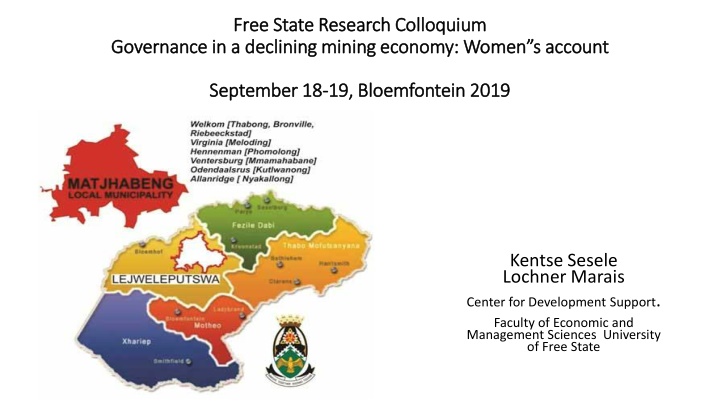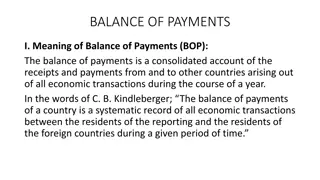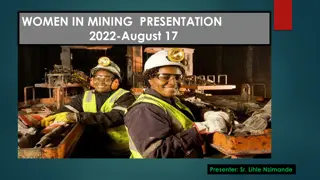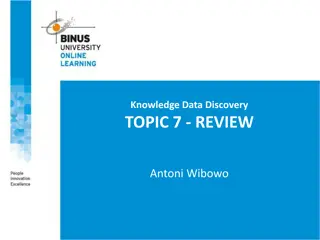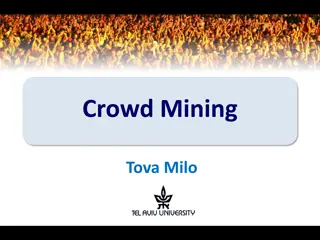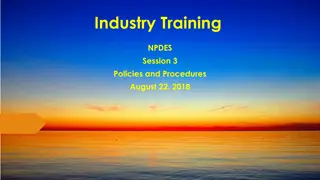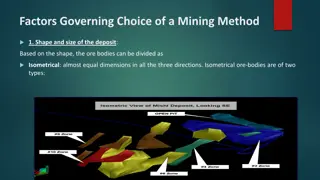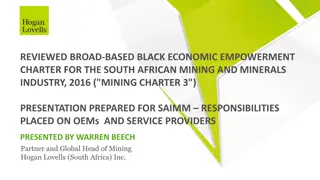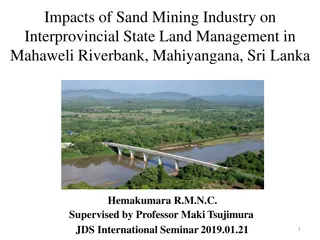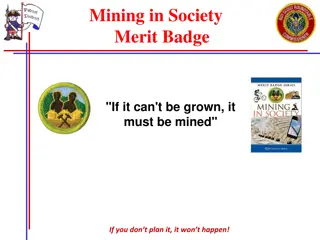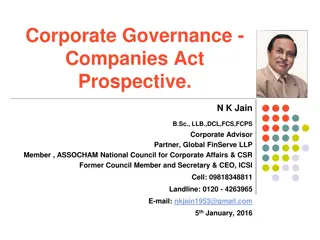Governance Challenges in a Declining Mining Economy: Women's Account in Matjhabeng, Bloemfontein 2019
Briefly explore the impact of mine decline on governance and women's livelihoods in Matjhabeng, with a focus on resource curse theory, institutional weaknesses, and socio-environmental impacts. The study aims to bridge the gap in gender literature and shed light on the experiences of women in a mining economy downturn.
Download Presentation

Please find below an Image/Link to download the presentation.
The content on the website is provided AS IS for your information and personal use only. It may not be sold, licensed, or shared on other websites without obtaining consent from the author.If you encounter any issues during the download, it is possible that the publisher has removed the file from their server.
You are allowed to download the files provided on this website for personal or commercial use, subject to the condition that they are used lawfully. All files are the property of their respective owners.
The content on the website is provided AS IS for your information and personal use only. It may not be sold, licensed, or shared on other websites without obtaining consent from the author.
E N D
Presentation Transcript
Free State Research Colloquium Free State Research Colloquium Governance in a declining mining economy: Governance in a declining mining economy: Women s Women saccount account September 18 September 18- -19, Bloemfontein 2019 19, Bloemfontein 2019 Kentse Sesele Lochner Marais Center for Development Support. Faculty of Economic and Management Sciences University of Free State
Figure 1: Mine production, employment for South Africa and Matjhabeng and the urban population for Matjhabeng, 1960 - 2017 800000 700000 600000 500000 400000 300000 200000 100000 0 60 70 75 76 77 78 79 80 81 82 83 84 85 86 87 88 89 90 91 92 93 94 95 96 97 98 99 00 01 02 03 04 05 06 07 08 09 10 11 12 13 14 15 16 17 National production (kg) Mine employment in Matjabeng National gold mine employment Urban population in Matjhabeng
Introduction Brief History of Gold fields /Matjhabeng Aim of the study Literature - key texts and themes Methodology Findings ( mines, local government, women) Implications of the current trajectory
Aim Part of a much broader study looks at how women survive in economic downturn in a resource economy, Close gap No attention to gender in literature Mine decline - Economic theory - Resource curse Theory lacks gender focus
Literature Resource Curse Theory is premised on the following: Mine resource depletion is inevitable, yet economic decline resulting from resource depletion is not. In the Third world economic decline follows resource depletion because is a function of structural impediments: - Economy Vulnerability (Boom-bust cycles) Fluctuating revenues ( Sachs and Warner, 1995) Undiversified economy/single commodity dependent Lack of integration into the local economy Institutions Institutional Weaknesses, Poor checks and balances because of boom and bust cycle ( Marais, 2015: Matrinez- Fernandez, 2012) Poor governance ( Holder, 2006) Leadership Myopic, Lack of planning capacity Largesse in government spending and borrowing Misappropriation of funds ( Karl, 2007; Frankel, 2012, Hodler, 2006) Resilience differs from continent to continent, but these are common features ( Viega et al., Leadbeater, 2008) which lead to financial strain and budget deficits during downturns ( Humphreys et al., 2009)
Literature (cont) Impacts Socioeconomic issues Environmental destruction ( Martinez- Fernandez and Wu, 2007) Pollution, lung diseases, Contamination of ground water ( health impacts on women- household chores) ( Harvard Law School, 2016) Loss of identity- Pressure some of the members to relocate ( Shandro et al 2011) Rapture of social fabric (Solomon et al., 2009) Divorce, Depression, Drug abuse, ( Ostry et al., 2000, 2001; Nelson et al., 2010) Sex work, Gender based violence( Shandro et al., 2011; Peats, 2008) Outmigration ( who goes?) Loss of revenue Service delivery failure Externalisation of HIV/Aids management to the state as mine clinics close Mining is the biggest driver of HIV/Aids (15%) points above average infection rate ( Corno and Walque, 2012; World Bank, 2012)
Government commitments National gender policy framework Gender mainstreaming machinery Provides framework for interaction Centers gender equality in the transformation processes in SA Requires integration of gender concerns. Despite the enthusiasm, to establish structures that will drive policy implementation, there are notable failures as explained by the following challenges: Poor information flow ( AfDB Report, 2009; COSATU Report, 2012) Poor resourcing (R77million, Presidency including OSW) / CGE (67million/HRC 9R115m) period 2014/2015 Parliament report ( 2008/2009) Understaffing, unable to fill senior positions
Methods Qualitative Feminist Critiques, Empowering-Centers women s experience multivariate techniques ( In-depth ( 12) and focus groups 80) Purposive sampling domestic, unemployed, self employed informal sector traders ( Bryman, 2004) Structured interviews ( Mine managers and municipal interviews) Desktop Study Rationale Richer data ( Meth and Clymont, 2009) Right to reply for policy failures ( Duke,2002) Triangulation for the researcher and validation ( mason, 2006; Bryman,2004; Richard,1996, Adam and Cox, 2008) Overcomes weaknesses and bises of a small sample ( Adams and Cox, 2008) Studying down perpetuates the marginal position and soesn help solve problems whereas reflecting marginal groups to see nature of the power and change or challenge it Focus group (robust discussion, often othering, however, a lot of tears In-depth interviews less tears, silence /claiming agency through silence? In-depth interviews more difficult to recruit than focus groups Right of Refusal of people to be subjected to a researcher s good intentions in a society where crime is normalised
Findings Local government- IDP Growth and expansion of services infrastructure ( IDP2018/2019) Inability to service the shrinking populace ( Denoon Stevens, 2019) Undermines capacity to service the expanded infrastructure amidst declining revenues and employment base.( van Heerden, 2016; Marais, 2013) Problem of one size fits all planning tool ( unable to respond to local challenges- women integration into service offering Insufficiently nuanced to deal with economic mining decline. ( Denoon- Stevens, 2019) LED Low levels of funding (5%)- No strategy Partnerships with national organisations alignment with mandates - top- down ( Akudungu and Luabe,2013; Leigh and Blakely, 2013; Rodriguez- Pose and Tijmstra,2009) Failure to nuance the plans to local challenges which LED is about(( Akudungu and Luabe,2013; Leigh and Blakely, 2013; Rodriguez- Pose and Tijmstra,2009) Leads to worsening inequality gap ( Rgerson, 2014; Leigh and Blakely, 2913) LED seen as funding poems and fables while electorate demands houses and infrastructure lying in disrepair ( Municipal official) Infrastructure prioritised as it allows for scoring political points and kickbacks (Akudungu and Luabe, 2013)
Local government cont LED conception limited to microprojects eg arts and crafts space for exhibition from time to time Lack of economic stimulus strategy to help absorb excess labour. Entrenchment of inequalities Poverty Lack of entrepreneurial support All hinge on the strength of local leadership ( Binns and Nel, 1999) Planners incapacity to plan- to reframe decline as an opportunity, a lost chance to re-invision post mining economies and to explore non traditional approaches at a time when cities need them- era where planning is hamstrung by politics
Local government cont No gender policy Women s free labour keeps men in power ; required to canvass votes during elections with promise for jobs which never come Women s work as subsidy for government- Required to clean streets without pay ( 3 years) without pay with promise for jobs Women s work is contingent In job creation programmes while men are in permanent jobs. Sex for work Cash for work HIV infection accepted as an outcome for access to jobs ( 6months into work) Few options ( face hunger or accept HIV infection) In an era of women empowerment, rules of engagement have been bent to suit men, - objectification of women.
Mine 5-10% women employment (Jensen, 2014) Women exclusion despite education ( Medisins San Frontier, 2016) Global challenge 2 chairpersons of boards of 100 top companies globally ( Women in Mining (UK) and PWC, 2014) Barriers to entry recruitment practices sex for jobs cash for jobs Tjhonkola fitness tests that require women not to have periods or pregnancy at the time of testing Shift work underground ( women request men to do the work on the behalf ( Benya, 2010) the payment is through sex Implications HIV/ Aids Unplanned pregnancies sx months into the job Hampered prospects for promotion
Mines cont SLP Projects run by mines have limited impact silos- competitive in nature and public relations focused Benefit friends and family Lack of transparency in accessing benefits None of the women had benefited or heard of someone who benefited. strange in a small community where economic opportunities are scares and word travels fast. Lack of growth focus Pro-poor failure to integrate the two Women involved in noncore businesses such as catering and tailoring which are seldom procured Stakeholder coordination Mines take lead Municipality unsupportive : failure of cooperative governance (Ndaba, 2010; Marais, 2013; Rogerson Chamberlian. Calls for institutionalisation of collaboration either through the Act or through regulations
Womens experiences Exclusion from economic mainstream ( Municipality and mine jobs) even with qualifications Collapse of service delivery- filth spillage of sewage ( poor health outcomes) Lack of trust (municipality and mines) Often remember good old days of apartheid where jobs were easy to access Pushed into informal sector ( hawking, domestic work- relegation to poverty) Prostitution Illegalities, drug lords, human trafficking Women economic abuse and objectification Vulnerabilities are exploited Women s economic ascendancy is controlled by men
Implications Goldfields 100 years old depth of experience good learning platform SA ha several decades of mining, 4.1 trillion USD mineral reserves ( Baarties and Gounden, 2012) Current lapses in leadership have produced Virginia ghost town (Seccombe, 2015) Current development trajectory represents an unsustainable path to resource development Poor leadership Weak institutions Women exclusion It makes sense to empower women economically because they are the people who stay when mines and men go Pay for services Leadership of institutions Assist in the re-imagination of a post mining economy Carry the economic base of the town
